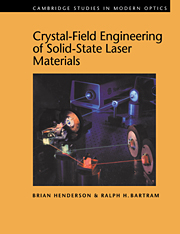Book contents
- Frontmatter
- Contents
- Preface
- 1 An introduction to lasers
- 2 Symmetry considerations
- 3 Optical crystals: their structures, colours and growth
- 4 Energy levels of ions in crystals
- 5 Spectra of ions in crystals
- 6 Radiationless transitions
- 7 Energy transfer and excited state absorption
- 8 Covalency
- 9 Engineering the crystal field
- 10 The crystal field engineered
- References
- Index
9 - Engineering the crystal field
Published online by Cambridge University Press: 24 September 2009
- Frontmatter
- Contents
- Preface
- 1 An introduction to lasers
- 2 Symmetry considerations
- 3 Optical crystals: their structures, colours and growth
- 4 Energy levels of ions in crystals
- 5 Spectra of ions in crystals
- 6 Radiationless transitions
- 7 Energy transfer and excited state absorption
- 8 Covalency
- 9 Engineering the crystal field
- 10 The crystal field engineered
- References
- Index
Summary
Principles and objectives
Crystal-field engineering seeks to use present knowledge to establish appropriate design principles for the development of new laser and nonlinear optical materials. First, the wavelength range of the optical device and its possible application (e.g. CW, ultrashort pulse, single frequency or tunable) are specified. This determines the chemical nature of the optical centre. The host environment is then selected, guided by historical knowledge of gain media or intuition of novel hosts with potentially beneficial properties, and then the theoretical and experimental techniques outlined in earlier chapters are invoked. The numerous objectives of crystal-field engineering include shifting the wavelength ranges of optical transitions, increasing the rates of radiative transitions and minimizing loss by nonradiative decay and excited state absorption. In addition, there may be reason to minimize or maximize energy transfer between centres, to avoid concentration quenching and to enhance laser efficiency respectively. Such objectives may be achieved by manipulating the unit cell containing the optical centre using such external perturbations as hydrostatic pressure, uniaxial stress or electric field. More usually, however, manipulating the unit cell is accomplished by changing its chemical composition.
Manipulating the unit cell
Hydrostatic pressure shortens bond lengths, reducing the unit cell dimensions without changing its symmetry. Such hydrostatic pressures will enhance the crystal field and, in consequence, shift spectra to shorter wavelengths. Studies of the Cr3+-doped elpasolites and garnets under pressure demonstrate the continuous tuning of the crystal field and of the coupling of the 2E and 4T2 states of the Cr3+ ion [Dolan et al. (1986), Hommerich and Bray (1995)].
- Type
- Chapter
- Information
- Crystal-Field Engineering of Solid-State Laser Materials , pp. 253 - 300Publisher: Cambridge University PressPrint publication year: 2000



